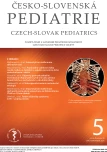Congenital pulmonary airway malformation and pulmonary sequestration – 15 years of experience at the Department of Pediatrics, University Hospital in Hradec Králové
Authors:
J. Micherová 1; P. Rejtar 2; B. Frýbová 3; Hubert Vaníček 1
Authors‘ workplace:
Dětská klinika LF a FN Hradec Králové
1; Radiologická klinika LF a FN Hradec Králové
2; Klinika dětské chirurgie 2. LF UK a FN Motol, Praha
3
Published in:
Čes-slov Pediat 2021; 76 (5): 267-275.
Category:
Review
Overview
Introduction: A set of patients from the Department of Pediatrics, University Hospital in Hradec Králové, with congenital pulmonary airway malformation (CPAM) and pulmonary sequestration (PS) from the year 2006 to 2020.
Objective: The aim of the survey is to assess the results of CPAM and PS management at our department and to compare them with literature.
Methods: There were diagnosed 23 patients with congenital thoracic malformation (CPAM and PS) from the year 2006 to 2020. An analysis of data (age at the time of diagnosis, type of imaging, symptoms, management).
Results: There were 11 patients with CPAM, 10 patients with PS and 2 patients with hybrid lesions (CPAM/PS) out of 23 patients with congenital thoracic malformation. Seventeen patients (74%) were diagnosed prenatally. Chest X-ray and ultrasound of the chest were done in all cases. Chest CT with angiography was always done prior to surgery. There was no detection of malformation using X-ray and ultrasound examinations in 6 cases, only with CT. Three malformations involuted (2x CPAM, 1x PS). Symptoms had 4 from 11 children with CPAM and 3 from 10 children with PS. Both children with hybrid lesions were asymptomatic. Three from 11 children with CPAM underwent surgery. The age of the patients at the time of resection were 3 months, 6 years and 7.5 years. Six from 11 children with CPAM are being monitored, the oldest is 4 years. Two CPAM involuted. Five from 10 children with PS underwent lobectomy in the age from 5 to 15 years. Four from 10 children with PS are monitored, the oldest is 4.5 years. One PS involuted, probably the extralobar. One of 2 patients with hybrid lesions underwent resection, the second is being monitored. There was one complication after surgery (a pleural effusion without the need of dranaige).
Conclusion: Congenital pulmonary airway malformation and pulmonary sequestration can be easily diagnosed prenatally. The asymptomatic lesions can pose a therapeutic dilemma as to when and how to treat and if any treatment is necessary at all. We still do not have enough data to predict changes in malformations in order to be able to optimalize our treatment.
Keywords:
congenital pulmonary airway malformation – CPAM – congenital cystic adenomatoid malformation – CCAM – congenital thoracic malformation – CTM – congenital lung masses – CLM – bronchopulmonary sequestration – PS
Sources
1. Wilmott WR, Chernick V, Boat FT, et al. Kendig and Chernick‘s Disorders of the Respiratory Tract in Children. 8th ed. Philadelphia: Saunders, an imprint of Elsevier Inc., 2012 : 317–376. ISBN: 978-1-4377-1984-0.
2. Pohunek P, Koťátko P, Tuková J. Dětská pneumologie. Praha: Mladá fronta a.s., 2018 : 284–301. ISBN 978-80-204-4912-2.
3. Egloff A, Bulas D. Congenital pulmonary airway malformation: Prenatal diagnosis and management. UpToDate, 2020.
4. Bulas D, Egloff A. Prenatal diagnosis and management of bronchopulmonary sequestration. UpToDate, 2020.
5. Oermann Ch. Congenital pulmonary airway (cystic adenomatoid) malformation. UpToDate, 2020.
6. Mafalda D, Ruben L, Tiago H. Prenatal and postnatal management of congenital pulmonary airway malformation. Neonatology 2016; 110 : 101–115.
7. Oermann Ch. Bronchopulmonary sequestration. UpToDate, 2020.
8. Lau CT, Kan A, Shek N, et al. Is congenital pulmonary airway malformation really a rare disease? Result of prospective registry with universal antenatal screening program. Pediatr Surg Int 2017; 33 : 105–108.
9. Min JY, Won HS, Lee MY, et al. Intrauterine therapy for macrocystic congenital cystic adenomatoid malformation of the lung. Obstet Gynecol Sci 2014; 57 (2): 102–108.
10. Fievet L, Natale C, D´Journo XB, et al. Congenital pulmonary airway malformation and sequestration: Two standpoints for a single condition. J Minim Access Surg 2015; 11 (2): 129–133.
11. Casagrande A, Pederiva F. Association between congenital lung malformations and lung tumors in children and adults: a systematic review. J Thorac Oncol 2016; 11 : 1837–1845.
12. Balkanli S, Özturk A, Köse M, et al. A report of adenocarcinoma in situ and congenital pulmonary airaway malformation in a three-day-old infant with a review of the literature. Turk J Pediatr 2014; 56 : 299–302.
13. Bagrodia N, Cassel S, Liao J, et al. Segmental resection for the treatment of congenital pulmonary malformations. J Pediatr Surg 2014; 45 : 905–909.
14. Baird R, Puligandla P, Laberge J. Congenital lung malformations: Informing best practice. Semin Pediatr Surg 2014; 23 : 270–277.
15. Laberge J, Puligandla P, Flageole H. Asymptomatic congenital lung malformations. Semin Pediatr Surg 2005; 14 : 16–33.
Labels
Neonatology Paediatrics General practitioner for children and adolescentsArticle was published in
Czech-Slovak Pediatrics

2021 Issue 5
Most read in this issue
- Congenital pulmonary airway malformation
- Iron deficiency anemia caused by malnutrition – case report
- Bulky gastroduodenal trichobezoar (Rapunzel syndrome) causing abdominal pain and anorexia in a nine-year-old female
- Congenital pulmonary airway malformation and pulmonary sequestration – 15 years of experience at the Department of Pediatrics, University Hospital in Hradec Králové
